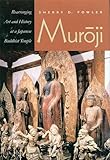Muroji : Rearranging Art and History at a Japanese Buddhist Temple / Sherry D. Fowler.
Material type: TextPublisher: Honolulu : University of Hawaii Press, [2005]Copyright date: ©2005Description: 1 online resource (312 p.) : color & b/w illusContent type:
TextPublisher: Honolulu : University of Hawaii Press, [2005]Copyright date: ©2005Description: 1 online resource (312 p.) : color & b/w illusContent type: - 9780824874582
- online - DeGruyter
| Item type | Current library | Call number | URL | Status | Notes | Barcode | |
|---|---|---|---|---|---|---|---|
 eBook
eBook
|
Biblioteca "Angelicum" Pont. Univ. S.Tommaso d'Aquino Nuvola online | online - DeGruyter (Browse shelf(Opens below)) | Online access | Not for loan (Accesso limitato) | Accesso per gli utenti autorizzati / Access for authorized users | (dgr)9780824874582 |
Browsing Biblioteca "Angelicum" Pont. Univ. S.Tommaso d'Aquino shelves, Shelving location: Nuvola online Close shelf browser (Hides shelf browser)
Frontmatter -- Contents -- List of Illustrations -- Acknowledgments -- Introduction -- Chapter one. Below the Surface of Mt. Murō -- Chapter two. Religious Affiliations and Contested Histories -- Chapter three. The Building and Rebuilding of Murōji -- Chapter four. Outside and Inside the Golden Hall -- Chapter five. Shifting Identities and Trading Places in the Golden Hall -- Conclusion: Manifestation of Multiplicity -- Appendix -- Notes -- Glossary of Japanese and Chinese characters -- Bibliography -- Index
restricted access online access with authorization star
http://purl.org/coar/access_right/c_16ec
Murōji, a magnificent temple founded in the eighth century, is known both for its dramatic location and the exceptional quality of its ritual objects and art dating from the ninth and tenth centuries of the Heian period. Sherry Fowler makes extensive use of primary sources to explore the circumstances surrounding the creation and function of the temple’s main images and considers why major works of early Heian sculpture were housed in such a remote mountain setting. Employing a multifaceted approach that looks at Murōji’s art and architecture in socio-political context, she explores the establishment of the temple, its role in the religious life and power structure of the region, and the ways in which the temple reconfigured its early history to suit its later circumstances. Emerging from Fowler’s study are pervasive themes relating to worship and practice at Murōji that highlight plurality of practice (of different schools of Buddhism as well as Shinto); flexibility of practice and its impact on sculptural icons; the relationship of Murōji to other temple/shrine complexes; and the association of the temple with women’s worship.
Mode of access: Internet via World Wide Web.
In English.
Description based on online resource; title from PDF title page (publisher's Web site, viewed 27. Jan 2023)









